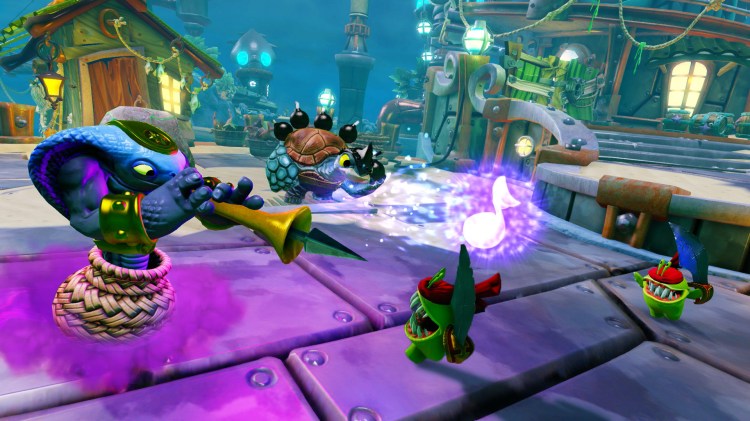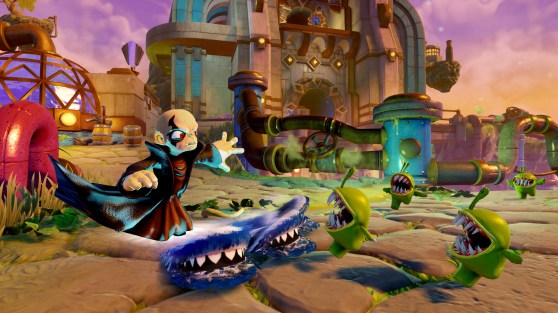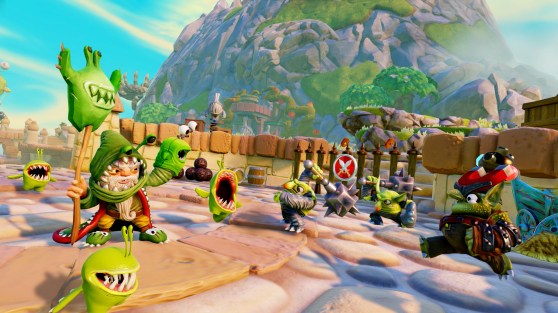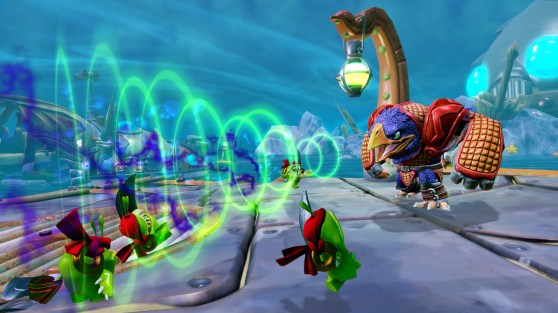Check out our Reviews Vault for past game reviews.
Skylanders: Trap Team offers young players serious fun in the form of trappable, playable villains. But do they have what it takes to overpower the Mouse House and its Disney Infinity 2.0 superheroes?
The Skylanders series of figurine-based adventures have earned solid reviews and become a $2 billion franchise. Its only major competition in the interactive-toy space is Disney Infinity, whose version 2.0 launched Sept. 23. (I gave it a 75/100 for GamesBeat.) Nintendo’s Amiibo may eventually give both games a challenge, but the company has yet to set a firm release date.
Each installment in the two series offers a new gimmick. For Disney Infinity, it’s the Marvel superhero theme. For Skylanders, it’s the ability to trap and play as the villains.
Skylanders: Trap Team is available now from Activision in a $75 starter pack that includes the game, two Skylanders figures, two traps, the “Traptanium portal” to put them on, and assorted paper goodies. The company created versions for PlayStation 3, PlayStation 4, Xbox 360, Xbox One, Wii, Wii U, and an intriguing tablet version for iOS, Android, and Amazon Fire, all at the same price.
Here’s how these two powerhouse games stack up:
Figures offer fun even when the television’s off
Both Skylanders and Infinity have a platform that plugs into your game console (or in Skylanders’ case, connects via Bluetooth to a tablet). Drop a figure on the platform and it appears in-game as a playable character.
Disney’s platform is a sleek sliver of silver with illuminated pads, basically enough to give your favorite Marvel superhero some attractive lighting. Translucent pieces called “Play Sets” change the world your heroes play in when you place them on the platform.
Skylanders’ lit-up corral-shaped object has a lump on one side with a port for the crystal-like trap pieces. It’s not as attractive, but the fencing around the platform might keep you from knocking off pieces, and the lump houses the speakers for the villains (more on that in a minute).
Disney’s $75 starter pack comes with three figures and a single Play Set. Skylanders comes with two figures. One is a trapmaster of a particular element (life/fire/water/air etc.) who can open doors of those types and get a leg up on battling villains of an opposing flavor; the other is a traditional character. You’ll also get two traps, which you can use to capture and play as villains.
Disney handily wins the battle of production values. The Marvel figures are beautiful, sculpted matte plastic. They feel substantial enough to withstand real-life play by a 5 year old, but the toys are detailed enough to look cute on top of the TV.
Neither series’ figures have movable joints. Skylanders’ figures are more attractive in-game than they are in the real world, where they feel cheaper than Disney’s and a little flimsier.
Both could use a serious dose of estrogen. I received almost every figure now available for both games, close to 30 little guys crowding the top of our TV stand, and fewer than five were female. That’s disappointing when you consider that girls in the ideal age range for these typically play games as often as boys.
Advantage: Disney
Adventures are short and sweet in both games
These games aren’t intended to offer serious challenges for adults. Even on hard mode, Skylanders won’t offer obstacles for young gamers unless they completely ignore how the bad guys are trying to damage their characters.
Neither offers extended amounts of gameplay. If you hurry, you can finish either in up to four hours.
Both offer a good amount of replayability. In Disney, that takes the form of new Play Sets that give you new worlds for your heroes to champion, each with its own series of simple quests, and the Toy Box, which is a sandbox area where you build your own challenges.
In Skylanders, you can open side areas with their own rewards by purchasing more trapmasters of the appropriate elements to open the doors, or play card-like side games.
Both give you the chance to play through with different heroes, depending on the figures you buy. Skylanders adds to that number with the villains you capture in appropriate-element traps, which you can then use to play as that evildoer in short bursts.
Advantage: Disney, for Toy Box content
Gimmicks add fun
Playing as Marvel superheroes in Disney Infinity 2.0 is a hoot. Each character has its own move set based on the hero. Flying is as fun as you’d expect, but characters without flight often get the added benefit of platformer-like levels to reach high places.
Skylanders’ traps shine as the best gimmick from either game. These allow you to download vanquished enemies into a plastic, vaguely crystal-shaped piece that you can then use to play them. When you defeat an enemy, you lock them up in a jail in your main play hub/home base; you choose which to load into the traps and make playable at any given time.
When you trap an enemy, the villain’s voice will go from your TV to the tiny speaker in the Traptanium portal, a nice touch. It’ll badger you if you don’t use it, and offer commentary on your gameplay.
You must have a trap of the proper element to capture each boss. Two come with the starter pack.
Most of the villains were far more interesting than the heroes to play, and the only bummer is that you don’t end up with figures to represent them that the kids can play with offline.
Advantage: Skylanders
Graphics and gameplay mechanics to entice the kids
Both games look surprisingly good. Skylanders, which has traditionally been a little rough on the eyes, has really improved. The water animations were so good I actually stopped to watch them and play in puddles.
Character animation is smooth and fluid in each, with bright colors and goofy personalities you would expect for games in this age group. Voice acting is top-notch, with familiar names voicing their characters.
Of the two, Disney has better stories and writing. Skylanders’ jokes felt stale, and the story feels like a lame rehash of Superman II: A huge prison is destroyed, releasing all the bad guys in the world.
Perhaps I’m feeling curmudgeonly, but I didn’t find either to have that magical Shrek-ish “make the adults laugh while the kids play” appeal. Jokes are strictly amusing for the school-age set.
Both offer couch co-op. Both offer upgrades. In Disney, it takes the form of an RPG-style skill set you earn with points. In Skylanders, it’s both new abilities bought with gold coins and wonderfully goofy hats and trinkets that upgrade your character.
The gameplay in the adventures is pedestrian. See an enemy, defeat an enemy, and do so again. Side games — the Toy Box in Disney, the lock puzzles and card games in Skylanders — offer a welcome respite.
Advantage: Disney








